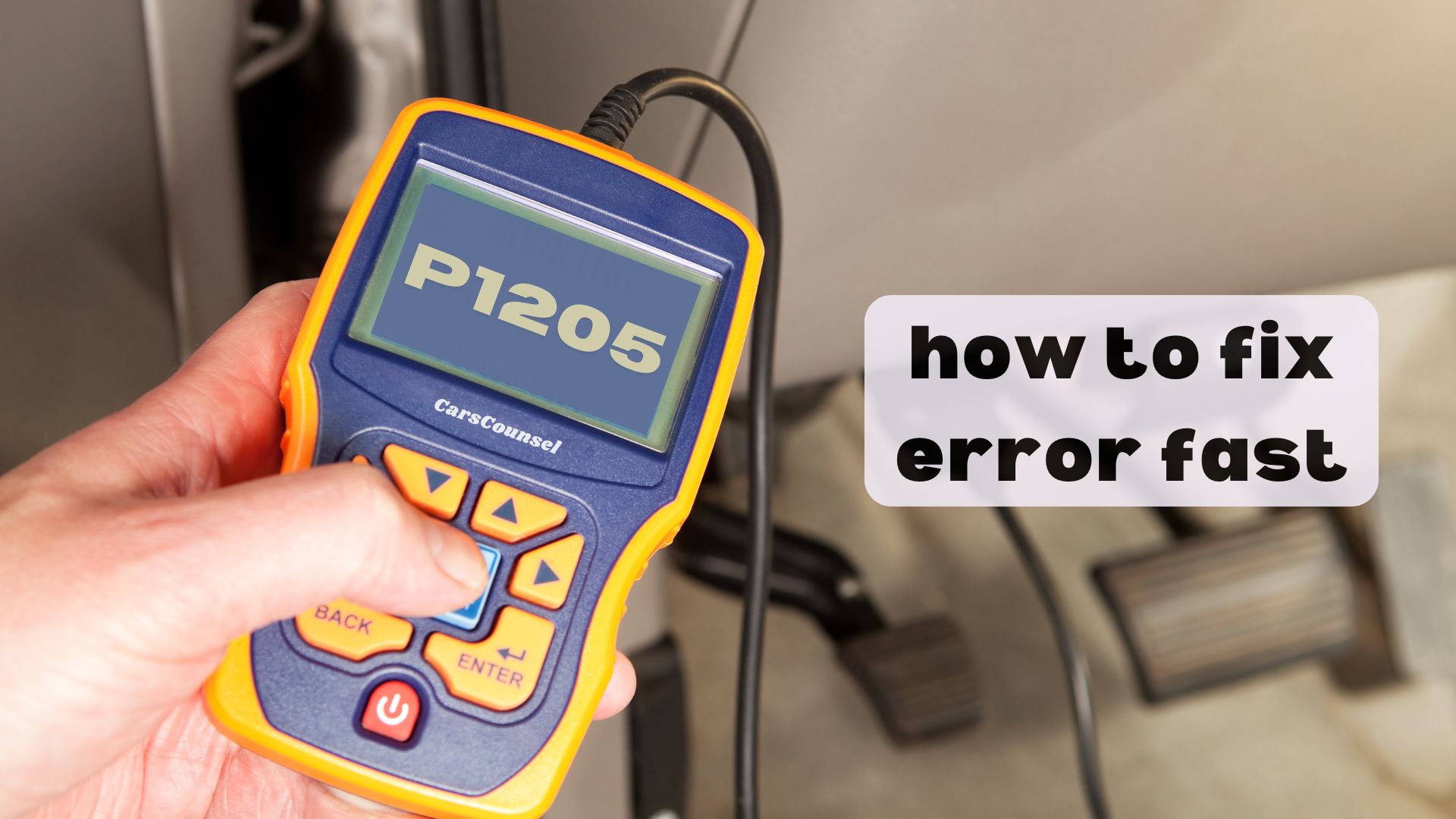As you scan your vehicle’s onboard diagnostics, you’re confronted with the cryptic code P1205. Don’t ignore it – this warning signal indicates a fuel system failure causing a misfire in your No. 5 cylinder. You’re likely experiencing rough idling, loss of power, and poor fuel efficiency. But what’s behind this malfunction? Is it a faulty fuel injector, low fuel pressure, or something else? You’ll need to dig deeper to uncover the root cause and prevent further engine damage.

Quick Navigation
Key Takeaways
- A P1205 code indicates a fuel system failure causing a misfire in the No. 5 cylinder, leading to poor engine performance and fuel efficiency.
- Common causes include faulty fuel injectors, low fuel pressure, clogged fuel filters, and ignition system issues specific to cylinder No. 5.
- Symptoms include rough idling, loss of power or acceleration, vibrations, and increased fuel consumption, accompanied by an illuminated check engine light.
- To fix the issue, diagnose the specific cause using a scan tool and fuel pressure gauge, and replace or adjust faulty components as needed.
- Prevent future fuel system failures by prioritizing regular maintenance, replacing fuel filters, and monitoring fuel pressure to detect potential issues early.
Code P1205 Description
When your vehicle’s onboard computer logs a P1205 code, it’s signaling a fuel system failure that’s causing a misfire in the No. 5 cylinder of the engine.
This failure can lead to a lack of power, rough idling, and poor fuel efficiency. Fuel pump issues or clogged fuel filters may be restricting fuel flow, resulting in improper fuel delivery to the cylinder.
As a result, engine performance suffers, and you may experience a loss of power or acceleration. Ignoring this error code can lead to further engine damage and costly repairs down the line.
Common Causes of P1205
As you investigate the root cause of the P1205 code, you’ll likely uncover one of several common culprits.
A faulty fuel injector in cylinder No. 5 is a prime suspect, as it can disrupt fuel delivery and cylinder performance.
Low fuel pressure in the fuel system, often caused by fuel pump issues, can also trigger this code.
Additionally, a clogged fuel filter or malfunctioning fuel pressure regulator can restrict fuel flow, leading to misfires.
Ignition system issues specific to cylinder No. 5 may also be to blame.
Symptoms of P1205
Identify the warning signs of a P1205 code by paying attention to your vehicle’s performance.
You may notice rough idling, which can be accompanied by a loss of power or acceleration. The check engine light will likely be illuminated, and you might feel vibrations or shaking while driving.
Additionally, you may experience increased fuel consumption, which can negatively impact your fuel efficiency.
These symptoms can be frustrating and costly if left unaddressed, so it’s essential to address the underlying fuel system failure and misfire in cylinder No. 5 promptly.
How to Fix P1205
To fix the P1205 code, you’ll need to diagnose the specific cause of the fuel system failure and misfire in cylinder No. 5.
This requires a thorough inspection of the fuel system to identify the root cause of the problem.
- Diagnose the specific cause of the fuel system failure using a scan tool and fuel pressure gauge.
- Inspect and replace the fuel injector in cylinder No. 5 if it’s faulty.
- Check and adjust fuel pressure in the fuel system to guarantee proper delivery to all cylinders.
- Replace the fuel filter if it’s clogged and restricting fuel flow, as part of regular fuel filter maintenance.
Cost to Fix P1205 and Additional Information
About $200 to $800 is what you can expect to pay to fix a fuel system failure causing a No. 5 cylinder misfire, depending on the specific issue and your vehicle’s make and model. This estimate includes parts and labor costs, but diagnostic time and labor rates can vary between auto repair shops. To get a more accurate estimate, obtain quotes from several shops.
| Repair Estimates | Fuel Costs |
|---|---|
| $200 – $500 | 10% – 20% increase |
| $300 – $600 | 15% – 30% increase |
| $500 – $800 | 20% – 40% increase |
| Diagnostic time | Varies by shop |
What Is a Fuel System Failure?
A well-functioning fuel system is essential for your vehicle’s engine to run smoothly, and a failure in this system can lead to a multitude of problems, including the P1205 code.
You should be aware that fuel system failure can be caused by various issues, including:
- Fuel pump issues that prevent proper fuel delivery to the engine.
- Clogged fuel filters that restrict fuel flow to the engine.
- Malfunctioning fuel pressure regulators that disrupt fuel pressure.
- Neglecting regular vehicle maintenance, such as fuel system checks and filter replacements.
Understanding Fuel Injector Issues
Fuel injector issues are a common culprit behind fuel system failures, including the P1205 code.
You’ll want to inspect the fuel injector in cylinder No. 5, as it may be clogged or dirty, preventing proper fuel spray. Try fuel injector cleaning to see if that resolves the issue. If not, replacement may be necessary.
Inspect cylinder No. 5’s fuel injector for clogs or dirt, and try cleaning before replacing if necessary.
Additionally, if you’ve recently had fuel pump replacement, it’s possible the new pump isn’t providing sufficient pressure, affecting fuel delivery to the injector.
Certify the fuel system is functioning correctly to prevent further misfires and engine damage. Verify the fuel system is functioning correctly to prevent further misfires and engine damage.
Fuel Pressure Regulator Malfunctions
The malfunctioning fuel pressure regulator is a pivotal component to examine when diagnosing the P1205 code, as it plays a paramount role in maintaining the ideal fuel pressure required for proper engine operation.
When the regulator fails, it can lead to low fuel pressure, causing the engine to misfire and reducing fuel efficiency.
To address this issue, you should:
- Check the fuel pressure gauge to identify any deviations from the recommended pressure range.
- Inspect the regulator for signs of wear or damage.
- Perform a fuel system leak-down test to identify any leaks or restrictions.
- Consider regulator replacement if the issue persists, as this can restore perfect fuel pressure and engine performance.
Diagnosing Fuel System Problems
What’s causing your engine’s fuel system to malfunction?
To diagnose the issue, you’ll need to perform thorough fuel system checks.
Start by checking the fuel pressure gauge to identify any abnormalities.
Next, conduct a fuel pump diagnosis to rule out any issues with the pump itself.
Inspect the fuel filter for clogs and replace it if necessary.
Use a scan tool to retrieve trouble codes and monitor live data to pinpoint the problem.
Preventing Future Fuel System Failures
After identifying and repairing the root cause of the P1205 code, you’re likely wondering how to prevent future fuel system failures.
To avoid another costly repair, prioritize fuel system maintenance.
This includes:
- Regular tune-ups: Guarantee your vehicle is serviced at recommended intervals to catch potential issues before they become major problems.
- Fuel filter replacements: Replace your fuel filter every 15,000 to 30,000 miles to prevent clogs and restricted fuel flow.
- Fuel injector cleaning: Clean your fuel injectors regularly to prevent clogs and maintain ideal fuel delivery.
- Fuel pressure monitoring: Keep an eye on your fuel pressure to detect any potential issues before they cause a misfire.
More OBD-II Codes
| P1389 | P1479 | P1480 | P1481 |
| P1482 | P1483 | P1484 | P1485 |
| P1486 | P1291 | P1292 | P1293 |
| P1294 | P1226 | P1209 | P1210 |
| P1204 | P1202 | P1203 | P1198 |
| P1146 | P1145 | P1144 | P1143 |
Frequently Asked Questions
Can I Drive My Car With a P1205 Code?
When driving with a P1205 code, you risk further engine damage, decreased fuel efficiency, and potentially costly repairs. Prioritize repair to avoid these driving risks; addressing the fuel system failure and misfire should be your top priority to guarantee safe and efficient vehicle operation.
Will a Tune-Up Fix the P1205 Code?
You’re wondering if a tune-up will fix the P1205 code. Unfortunately, a standard tune-up, which typically includes replacing spark plugs, won’t address the root cause of the issue, as it’s likely related to faulty fuel injectors or low fuel pressure.
Can a Faulty Oxygen Sensor Cause a P1205 Code?
You’re wondering if a faulty oxygen sensor can cause a P1205 code. Technically, it’s unlikely, as the sensor’s location is downstream of the cylinders, and its malfunction wouldn’t directly affect fuel system pressure or injector performance, making sensor replacement unlikely to fix the issue.
How Long Does It Take to Fix a P1205 Code?
Imagine a detective solving a mystery – that’s what diagnosing a P1205 code is like. You’ll need about 1-2 hours for the diagnostic process, and the repair timeline can range from 30 minutes to several hours, depending on the root cause and complexity of the issue.
Will a Fuel System Cleaning Fix the P1205 Code?
When you consider a fuel system cleaning to fix the issue, it may not be enough to resolve the problem, as a faulty fuel injector or low fuel pressure could still be causing the misfire, and a more in-depth diagnosis is required to identify the root cause.
Conclusion
As you sit behind the wheel, feeling the rumble of a misfiring engine, bear in mind that overlooking the P1205 code can lead to a pricey repair bill down the road. On the other hand, addressing the faulty fuel injector, low fuel pressure, or clogged fuel filter head-on can get your engine purring like new again. Don’t let a small problem snowball into a major headache – tackle that P1205 code today and breathe new life into your vehicle.

